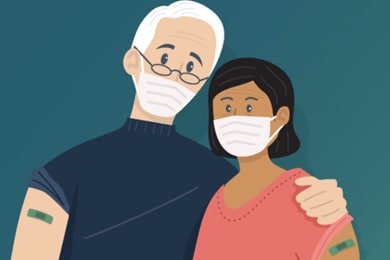View Infographic
#17,740
As I mentioned in my last blog (see WHO COVID Update - Variant Evolution Paper & CDC Nowcast), while XBB lineage variants are overwhelmingly in control in the United States, in Europe a new lineage (BA.2.86) has been making inroads for several months, and is of concern because it boasts a large number of mutations in its spike protein.
While BA.2.86 hasn't taken off as quickly as some initially feared, it has spawned a new variant - JN.1 - which carries the L455S mutation, and it appears to have an added growth advantage; at least based on early reports from France.
While it is too soon to predict what impact - if any - JN.1 will have this winter, yesterday the CDC released the following statement:
Variants Happen
October 27, 2023, 4:00 PM EDT
CDC is posting updates on respiratory viruses every week; for the latest information, please visit CDC Respiratory Virus Updates.
The SARS-CoV-2 virus has many variants
Viruses are constantly changing over time. These changes – or variants – happen when viruses infect cells and begin to reproduce, and some of the resulting copies contain errors. Sometimes these changes enable the new variant to spread more quickly or effectively. In this case, that new variant may become more common relative to other variants that are circulating.
Because these viral changes continue to happen, CDC is constantly tracking their emergence and spread and closely studying new variants. Our process begins with genomic surveillance. CDC works with partners in the United States and around the world to track changes to the SARS-CoV-2 virus and publish those findings.
CDC recently published two new reports describing how multiple types of genomic surveillance were used to track a new variant in August 2023 – Early Detection and Surveillance of the SARS-CoV-2 Variant BA.2.86 and Notes from the Field: Early Identification of the SARS-CoV-2 Omicron BA.2.86 Variant by the Traveler-Based Genomic Surveillance Program. CDC also works to understand how these changes might affect how the virus spreads, as well as how it responds to vaccines and treatments.
Some recent variants have more changes than others
Occasionally a variant appears that is very different from previous variants, much like Omicron when it was first detected. In these cases, it’s not always clear right away whether these very different changes will affect how the virus spreads or its health impact. For example, when scientists first identified the BA.2.86 variant in August 2023, they found that it appeared to be very different from other recently identified variants. This raised concerns that this variant might be more likely to spread and infect people, even people with immunity from vaccines and previous infections. However, later scientific data showed that the BA.2.86 variant has not evaded our immunity or spread quickly.
What about JN.1?
We are learning about a new variant called JN.1. JN.1 was first detected in September 2023 in the United States and has been detected in 11 other countries. With this limited information, it is too early to tell whether it will spread more widely. Neither JN.1 nor BA.2.86 is common in the United States right now. In fact, JN.1 has been detected so rarely that it makes up fewer than 0.1 percent of SARS-CoV-2 viruses.
Even though BA.2.86 and JN.1 sound very different because of the way variants are named, there is only a single change between JN.1 and BA.2.86 in the spike protein. The spike protein – called a “spike” because it looks like tiny spikes on the virus’ surface – plays a crucial role in helping the virus infect people. Because of this, the spike protein is also the part of a virus that vaccines target, meaning vaccines should work against JN.1 and BA.2.86 similarly. For example, initial scientific data show that the updated 2023-2024 COVID-19 vaccines help our immune systems block BA.2.86. We expect JN.1 will be similar. We also expect treatments and testing to remain effective based on analysis conducted by the SARS-CoV-2 Interagency Group (a group of scientific experts representing many government agencies).
What does this mean for me?
While new variants like BA.2.86 and JN.1 attract attention, right now, 99 percent of SARS-CoV-2 variants are part of the XBB group of the Omicron variant, which is what this year’s updated vaccines are based on. CDC is continuing to track the spread and impact of BA.2.86 and JN.1, as well as other variants as they come and go.
For as long as we have COVID-19, we’ll have new variants. Nearly all represent relatively small changes compared with previous variants. CDC and other agencies monitor for impacts of new variants on vaccines, tests, and treatments, and will alert the public quickly if anything concerning is detected. Most of the time, new variants make little to no impact.
Regardless of the variant, all SARS-CoV-2 viruses spread the same way. So it’s important to protect yourself and others by staying up to date with COVID-19 vaccines, improving ventilation and staying home when you’re sick.
Although the CDC is putting a lot of stock in the protection provided by the new COVID vaccines, thus far their uptake has been disappointing. Data presented by the CDC on Thursday shows only 7.1% of adults have gotten the jab, and only about 2% of children and adolescents.
Equally dismal are the number of people who plan to get the vaccine in the near future.
Their second recommendation - improving indoor ventilation - is always a good idea, but that become problematic for most of the country as winter sets in. Staying home while sick makes sense as well, but schools and employers are far less forgiving of taking sick days than they were a year or two ago.Noticeably absent from the above recommendations are the use of face masks, even though the virus is airborne, and masks (when properly and consistently worn) have a proven track record of reducing the transmission of COVID and other respiratory viruses.
While not currently politically popular, if you follow the CDC link on protecting yourself, you'll find that face masks are still listed, along with social distancing.
Prevention Actions to Add as Needed
There are some additional prevention actions that may be done at any level, but CDC especially recommends considering in certain circumstances or at medium or high COVID-19 hospital admission levels.
Wearing Masks or Respirators
Masks are made to contain droplets and particles that you breathe, cough, or sneeze out. A variety of masks are available. Some masks provide a higher level of protection than others.
Respirators (for example, N95) are made to protect you by fitting closely on the face to filter out particles, including the virus that causes COVID-19. They can also block droplets and particles you breathe, cough, or sneeze out so you do not spread them to others. Respirators (for example, N95) provide higher protection than masks.
When wearing a mask or respirator (for example, N95), it is most important to choose one that you can wear correctly, that fits closely to your face over your mouth and nose, that provides good protection, and that is comfortable for you.
Increasing Space and Distance
Small particles that people breathe out can contain virus particles. The closer you are to a greater number of people, the more likely you are to be exposed to the virus that causes COVID-19. To avoid this possible exposure, you may want to avoid crowded areas, or keep distance between yourself and others. These actions also protect people who are at high risk for getting very sick from COVID-19 in settings where there are multiple risks for exposure.
Monoclonal antibodies - which were once touted as a game-changer for the treatment of COVID - are no longer effective. Resistance to Paxlovid remains low, but that happy state of affairs may not last forever (see Paxlovid Resistance: Is It Just a Matter of Time Now?).



